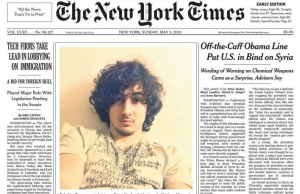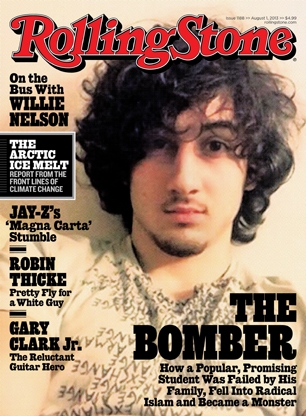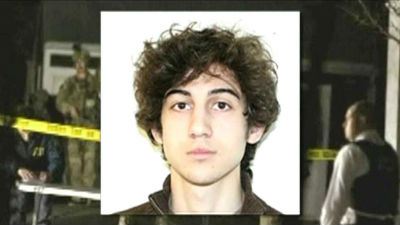Facts are stubborn things; and whatever may be our wishes, our inclinations, or the dictates of our passions, they cannot alter the state of facts and evidence; nor is the law less stable than the fact. —John Adams, Summation, Rex v Wemms (1770)
I wasn’t planning a follow-up to yesterday’s post about the Rolling Stone cover story on Boston Marathon bomber Dzhokar Tsarnaev. Then I saw all the outrage and realized there was more to this than the magazine’s editorial motive.
This is a case study in how caught up people get in the bandwagon mentality.
Mood music:
Consider this: People are outraged over the magazine cover because they feel it portrays Tsarnaev as a teen heartthrob. But the picture has been floating around for months and The New York Times used in back in May. No one said boo at the time. The picture shows an innocent-looking kid who is anything but innocent, but it’s real.
Nevertheless, after a few people expressed anger over the Rolling Stone cover, people started tripping over each other to rage in a delirious rush to find a seat on the bandwagon. Some stores announced they wouldn’t carry this issue of the magazine because they were taking a stand against such sensationalistic madness. In my opinion, they’re just trying to capitalize on the anger and get some good brand PR.

Consider this: A few weeks back, amid a tidal wave of public joy over the Supreme Court striking down the Defense of Marriage Act (DOMA), The New Yorker displayed an issue cover that depicts Sesame Street characters Bert and Ernie snuggling together in from of a TV displaying the justices. Most of the response was positive. People gushed about how this demonstrates how far we’ve come in accepting people for who they were, regardless of sexual orientation, race and so on.
But the cover takes liberties with the truth. Sesame Street has said that those characters are not gay. In fact, its puppets are without sexual orientation, period.
Go ahead and tell me you can’t possibly compare the two covers, that Sesame Street is a children’s show. The characters on Sesame Street are very real to children, and The New Yorker made two of the characters out to be something they’re not.

Personally, I wasn’t bothered by The New Yorker cover. To me, it was an artist merely expressing his emotions over the death of DOMA. I wasn’t bothered by the Rolling Stone cover, either. I thought the image with the headline and summary set the reader up for an important case study in how a seemingly good kid goes astray, espouses evil and becomes a monster.
Someone noted yesterday that terrorists crave the limelight and want to be on the cover of magazines. Perhaps that’s true. But we need to see their faces, too, so we know who our enemies are. That’s why evil people make the cover of news magazines all the time.
When there’s a bandwagon to jump on, however, the truth gets trampled underfoot. People latch on to memes on Facebook every day that have absolutely no basis in truth. The image and text capture the outrage they feel, so the facts become unimportant.
The outrage over the Rolling Stone cover is, to me, another example of that. With emotions still raw (mine included) over the Boston bombings, people want ways to vent their spleen. Seemingly offensive photos and magazine covers will do the trick every time. Maybe that’s not a bad thing; having outlets to express our pain is healthy and helps us move on.
Yet when we spend too much time on a bandwagon fueled by rage, we’re bound to choke on the exhaust.



